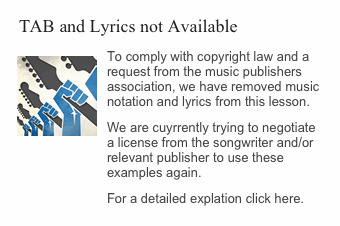As Tears Go By – The Rolling Stones

Let’s wrap up, for the moment at least, our look at walking bass lines with the classic Rolling Stones’ song, As Tears Go By. Marianne Faithfull’s cover of this song, which is how many people came to know it in the first place, was recorded and released before the Stones recorded their own version, and amazingly (not counting their playing it on Ed Sullivan), wasn’t played on a Rolling Stones tour until November 2005.
Be that as it may, let’s take a quick moment to note two things concerning our lesson: First, when I say “wrap up,” I’m lying. Not to mention making a bad, if late, joke concerning Christmas presents. It’s kind of silly to say that we ever wrap up anything in these lessons, because one of the purposes behind them is to give you ideas and tools that you can use no matter what song you’re playing. We’ll be seeing lots of walking bass lies in the future. I’m just hoping I don’t have to explain them from scratch.
The second thing is that we’ll also use this lesson to give us a bit of an introduction into the idea of cross picking. But more on that in a moment…
In terms of structure, As Tears Go By is made up of three verses, four if you count an instrumental verse between the second and third verses. Each verse contains four lines and the first two lines have the same chord progression. Have a look:
As you can see here, there’s nothing you can’t handle. So if you’d like, pick a strumming pattern and go. Here’s one that will work nicely:
This is, of course, one of countless patterns that will work for this song. I’ve chosen this particular strumming pattern in order to help us make incorporating a walking bass line a little easier. Also, being sneaky, having both the pattern and the walking bass line will make our look at cross picking a little easier as well.
I should also mention here that, while I’m fairly certain these are the right chords; I’ve heard all sorts of chord substitutions in the numerous arrangements of this song that I’ve heard over the years. Some folks use A7 instead of A. Some like the sound of Am or Am7 instead of A. And, as you’ll see towards the end of the lesson, there’s all sorts of suspended chords and fills and ornamentation you can add when you’re playing.
So let’s use this strumming pattern and chord progression as a template and get going with a walking bass line. At this point, I hope, you’ll see it as nothing more than “connecting the dots” between the root notes of the chords:
After going through the lessons on You Are My Sunshine and Connecting the Dots, Part 3, this sort of thing will hopefully be old hat to some of you by now. The only somewhat tricky part involves using the open low E (sixth) string for the E and F# notes when you change from the D to the G chords. A lot of people find it easy to hook one’s thumb over the top of the neck to get that F#, but since you’re not playing any chord at that point, just using the index or middle finger should work fine.
If you are comfortable with what we’re doing to this point, that’s cool because that allows you to start trying some other variations. For example, you could stagger the strumming and the bass line on the section where the chords change from G to Em:
Again, you can use either your thumb or a finger to get the F# note in the bass. Not worrying about hitting the B note (second fret of the A string) of a “normal” G chord does have some advantages!
While this first variation may not seem like that big of a change, it makes a big difference to the listener, if for no other reason that you’ve broken up the strumming / rhythm pattern that you’ve been using for the first two and a half lines of the verse. Little subtleties such as this are how you keep from being robotic, playing the same strumming or rhythm pattern over and over and over again.
The second variation carries the “new” rhythm pattern (which, as you’ve already figured out, is the same rhythm that we used for the original strumming template.
You can likewise tinker around all throughout the song. Here are some suggestions for the very last line, where you change from D to D7:
The first variation uses notes of the D chord (D and A, of the open D and A strings respectively, and F# at the second fret of the low E string) before going back to the open E and F# to walk back up to G. Here you might definitely find using your thumb an advantage in fretting your bass note of F#.
Things get a little more complicated with the second variation even though, to the ears at least, it’s a simple descending walking bass line. Simple to the ears, but you’ll want to take some time sussing out the fingering. Personally, I find myself using my pinky to get the C note (third fret of the A string) in the bass and then changing my whole fingering around – index finger on the B (second fret of the A string) in the bass while my middle, ring and pinky reform the D chord in the high strings. Some people like forming a “mini-barre” chord, using their index finger to cover the second fret of the high three strings and getting the D at the third fret of the B string with either the ring finger or pinky. This frees up the middle finger for the bass notes. Take you time with this variation and be prepared to do some practicing!
The third variation sounds a lot more complicated than it actually is. One starts out with the normal D chord and then adds a pinky to the third fret of the high E (first) string to get the G note (technically turning the whole thing into Dsus4), then removes it to get the second fret again and then opens up the first string entirely for the E note. While we could spend ages debating that we’ve created a Dsus2, it’s all merely ornamentation.
The second measure of this variation can all be done with pull-offs if you wish. Sounds very cool, in fact!
In and of itself, there’s enough here to mess around with without going any further. But I’d like to take one last step (or two) forward, if for no other reason than to give you more to think about. What we’re going to try to do is to pick individual strings in place of the strumming of chords. Some people call this flat picking, some call it cross picking and I’m not here to debate terminology. To me, it’s just part of playing. Let’s start with the G chord and work through the first line:
Here, regardless of the chord, we’re starting with the root note on a downstroke and then hitting the high E (first) string with an upstroke, then a downstroke on the D string and finally an upstroke on the B string. You’ll find this a lot easier using alternate picking and you may also simply find playing chords in this manner a good exercise to help you get better at alternate picking. Even if you miss the string you want, you’ll hit another note in the chord as long as you keep the chord in place with your fingers.
And frankly, no one’s going to know if you make a mistake unless you start swearing! I can’t stress enough here that this is, again, one of many patterns that you can play. And I also want you to listen to something – in the MP3, I play the first line exactly as written out and then go and then just play the rest of the verse without worrying about the pattern. To my ears, things sound a lot better when I’m not worried about it. Why? Because then I’m playing and not being a tape recorder is certainly part of it. But as I just mentioned, as long as I keep my chord shapes, there’s not going to be a bad note. Most songs don’t require you to use a single pattern throughout. Doing so, in fact, makes you sound like you’re just a looping device. More importantly, it tires you out as much as it does your listener.
As a guitarist, you’re not going to be playing in front of people and muttering under your breath “…root note, high E string, D string, B string, root note…” Trust me, you don’t want to be! Right now you merely want to be thinking “bass, high, middle, high-ish” and getting yourself comfortable with playing in this manner. Before long, you’ll be able to add in bass notes as well:
You’ll have to forgive me for only giving you the first two lines as a start. You’re actually getting off better than my private students, who have to come back to me in a week’s time with whatever they’ve dreamed up as an accompaniment for this song. A lot of times, and this is when I know they’ve got the point, they’ll play it slightly differently in each verse and not be totally conscious of what they’re doing. You might end up with something like this:
Or something totally different. But that’s the whole idea.
As always, I hope that you’ve had fun with this lesson and have learned a few things about walking bass lines in the past few months. In the near future, we’ll be looking at how to combine strumming with picking and will, hopefully, be sounding a lot more like musicians and less like people who panic without patterns!
Until our next lesson…
Peace

